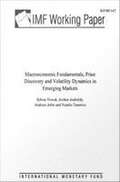- Table View
- List View
Macroeconometric Methods: Applications to the Indian Economy
by Pami DuaThis book provides empirical applications of macroeconometric methods through discussions on key issues in the Indian economy. It deals with issues of topical relevance in the arena of macroeconomics. The aim is to apply time series and financial econometric methods to macroeconomic issues of an emerging economy such as India. The data sources are given in each chapter, and students and researchers may replicate the analyses.The book is divided into three parts—Part I: Macroeconomic Modelling and Policy; Part II: Forecasting the Indian Economy and Part III: Business Cycles and Global Crises. It provides a holistic understanding of the techniques with each chapter delving into a relevant issue analysed using appropriate methods—Chapter 1: Introduction; Chapter 2: Macroeconomic Modelling and Bayesian Methods; Chapter 3: Monetary Policy Framework in India; Chapter 4: Determinants of Yields on Government Securities in India; Chapter 5: Monetar y Transmission in the Indian Economy; Chapter 6: India’s Bilateral Export Growth and Exchange Rate Volatility: A Panel GMM Approach; Chapter 7: Aggregate and Sectoral Productivity Growth in the Indian Economy: Analysis and Determinants; Chapter 8: Forecasting the INR/USD Exchange Rate: A BVAR Framework; Chapter 9: Forecasting India’s Inflation in a Data-Rich Environment: A FAVAR Study; Chapter 10: A Structural Macroeconometric Model for India; Chapter 11: International Synchronization of Growth Rate Cycles: An Analysis in Frequency Domain; Chapter 12: Inter-Linkages Between Asian and U.S. Stock Market Returns: A Multivariate GARCH Analysis; Chapter 13: The Increasing Synchronization of International Recessions.Since the selection of issues is from macroeconomic aspects of the Indian economy, the book has wide applications and is useful for students and researchers of fields such as applied econometrics, time series econometrics, financial econometrics, forecasting methods and macroeconomics.
Macroeconometric Models
by Władysław WelfeThis book gives a comprehensive description of macroeconometric modeling and its development over time. The first part depicts the history of macroeconometric model building, starting with Jan Tinbergen's and Lawrence R. Klein's contributions. It is unique in summarizing the development and specific structure of macroeconometric models built in North America, Europe, and various other parts of the world. The work thus offers an extensive source for researchers in the field. The second part of the book covers the systematic characteristics of macroeconometric models. It includes the household and enterprise sectors, disequilibria, financial flows, and money market sectors.
Macroeconomic Accounting and Analysis in Transition Economies
by Subhash Thakur Abdessatar OuanesA report from the International Monetary Fund.
Macroeconomic Adjustment in a Highly Dollarized Economy: The Case of Cambodia
by Mario De Zamaróczy Sopanha SaA report from the International Monetary Fund.
Macroeconomic Analysis
by Dirk NiepeltA concise but rigorous and thorough introduction to modern macroeconomic theory.This book offers an introduction to modern macroeconomic theory. It is concise but rigorous and broad, covering all major areas in mainstream macroeconomics today and showing how macroeconomic models build on and relate to each other. The self-contained text begins with models of individual decision makers, proceeds to models of general equilibrium without and with friction, and, finally, presents positive and normative theories of economic policy. After a review of the microeconomic foundations of macroeconomics, the book analyzes the household optimization problem, the representative household model, and the overlapping generations model. It examines risk and the implications for household choices and macroeconomic outcomes; equilibrium asset returns, prices, and bubbles; labor supply, growth, and business cycles; and open economy issues. It introduces frictions and analyzes their consequences in the labor market, financial markets, and for investment; studies money as a unit of account, store of value, and medium of exchange; and analyzes price setting in general equilibrium. Turning to government and economic policy, the book covers taxation, debt, social security, and monetary policy; optimal fiscal and monetary policies; and sequential policy choice, with applications in capital income taxation, sovereign debt and default, politically motivated redistribution, and monetary policy biases. Macroeconomic Analysis can be used by first-year graduate students in economics and students in master's programs, and as a supplemental text for advanced courses.
Macroeconomic Analysis and Economic Policy Based on Parametric Control
by Askar A. Ashimov Abdykappar A. Ashimov Robert M. Nizhegorodtsev Dmitriy A. Novikov Yuriy V. Borovskiy Zheksenbek M. Adilov Bahyt T. SultanovAfter the transition to free economy, governments of the former Soviet republics realized that in spite of becoming a part of the shaky international economic order, their individual economic success can be assured by rational national economic policies that in addition to the fundamental law of supply and demand govern the economic mechanism sensitive to both external and internal phenomena. Originally published in Russian and now translated in English, this book by Dr. A. Ashimov and his colleagues offers a novel theory providing a numerically-justifiable approach to the solution of major economy control problems that are faced by virtually every government in the world. First, they developed and validated numerous mathematical models describing complex interactions between economic and social factors thus enabling the decision makers to foresee the outcomes of their decisions. Second, on the basis of these models the authors formulated the appropriate control problems that could be interpreted as achieving the transition to the desirable economic regimes and maintaining these regimes in spite of initial conditions and both external and internal perturbations. It should be noted that due to the inherent uncertainty introduced by the use of statistical models, the nonlinearity of the underlying phenomena and the intention to obtain the optimal solutions, the solution process becomes quite intricate and calls for the application of the most sophisticated techniques offered in advanced control theory. The authors utilized the most instrumental statistical model validation techniques; they established sufficient conditions for the existence of optimal solutions of the relevant control problems; and they skillfully combined the applications of the phase space formalism, system stability analysis, and the methods of functional analysis. Finally, they developed algorithms resulting in the optimal problem solutions, thus offering economic policy makers a dependable decision support tool. Macroeconomic Analysis and Economic Policy Based on Parametric Control offers a novel, highly mathematical approach to the solution of very realistic economy control problems. It presents a good example of the application of mathematical modeling, advanced control theory, and model-based decision making that could be adopted by researchers and graduate students specializing in economics, control, and relevant areas of research, addressing their own research problems.
Macroeconomic Analysis and Parametric Control of a National Economy
by Askar A. Ashimov Abdykappar A. Ashimov Dmitriy A. Novikov Yuriy V. Borovskiy Zheksenbek M. Adilov Bahyt T. Sultanov Rakhman A. AlshanovThis is a sequel to the book by Dr. A. Ashimov and his colleagues, Macroeconomic Analysis and Economic Policy Based on Parametric Control. The authors have expanded both the developed mathematical apparatus and the scope of problems and applications stemming from the practice of steering a national economy of a small country in the dynamic environment of the international economic order. The developed theoretical foundation is used in Chapter 1 to suggest a decision support system operating in the framework of state economic policy making. Chapter 2 presents various mathematical models built on the basis of the available statistical data and provides quality assessment of these models. Parametric control problems are being formulated on the basis of these models as problems of mathematical programming, and the obtained solutions are subjected to analyses and interpretations. This is demonstrated by the analysis of the effect of uncontrollable factors on the problem solutions. Chapter 3 is aimed at the modelling and analysis of cyclic phenomena in economics and their structural stability. Chapter 4 presents solutions of specific problems of national economy and analysis and interpretation of their solutions. In summary, the authors formulate comprehensive mathematical models of some critical mechanisms in micro economics previously known only on a qualitative level. They provide vigorous mathematical analysis of the models that justifies their applicability for the formulation of parametric control problems, and the existence of model-based solutions. The complexity of the resultant problems is addressed by the formulation of the appropriate algorithms. The described methodology leads to the development of computer-based decision support systems.
Macroeconomic Analysis and Parametric Control of a Regional Economic Union
by Abdykappar A. Ashimov Yuriy V. Borovskiy Dmitry A. Novikov Bakyt T. Sultanov Mukhit A. OnalbekovThis book is a further development of the theory of parametric control. It includes: numerical methods of testing (verification) of software implementation of mathematical models by assessing the stability of mappings defined by the model; sufficient conditions for the existence of the solutions of some types of problems of dynamic optimization; the existence of continuous dependence of optimal values of criteria on exogenous functions and parameters; and the existence of points of bifurcation of extremals of such problems. It demonstrates that this theory offers a constructive methodology for middle-term forecasting, macroeconomic analysis and estimation of optimal values of economic characteristics on the basis of advanced global mathematical models, namely Computable General Equilibrium (CGE) Model, Dynamic Stochastic General Equilibrium (DSGE) Model, and Hybrid Econometric model. In addition, it includes conditions for the applicability of the computational experiments’ results, into practice.
Macroeconomic Analysis in the Classical Tradition: The Impediments Of Keynes’s Influence (Routledge Studies in the History of Economics)
by James C AhiakporMacroeconomic Analysis in the Classical Tradition explains how the influence of Keynes’s macroeconomics, including his changed definitions of some key macroeconomic concepts, has impeded many analysts’ ability to readily resolve disputes in modern macroeconomics. Expanding on his earlier work—Macroeconomics without the Errors of Keynes (2019)—the author delves into more aspects of macroeconomic theory and argues for a revision of Keynes’s contribution to the field. Attention is given to theories and concepts such as Say’s Law, the quantity theory of money, the liquidity trap, the permanent income hypothesis, 100% money, and the Phillips curve analysis. The chapters work to build a careful critique of Keynes’s economics and make the case that the classical macroeconomics of Smith, Say, Ricardo, Mill, and others could help resolve present-day policy disagreements and redefine macroeconomic priorities. This book provides essential reading for advanced students and scholars with an interest in the foundations of Keynes’s theories and current debates within macroeconomic policy.
Macroeconomic Analysis of Monetary Unions
by Carmen Díaz-Roldán Oscar Bajo-RubioThe book develops a general framework for the macroeconomic modeling of monetary unions. The starting point of the analysis is the standard two-country Mundell-Fleming model with perfect capital mobility, extended to incorporate the supply side in a context of rigid real wages, and modified so that the money market is common for two countries forming a monetary union. The model is presented in two versions: for a small and a large monetary union, respectively. After solving each model, the authors derive multipliers for monetary, expenditure, supply, and external shocks, both in the short and the long run; a graphical analysis is also provided. Special attention is paid to the crucial distinction between symmetric and asymmetric shocks.
Macroeconomic Analysis: Essays in macroeconomics and econometrics (Routledge Library Editions: Macroeconomics #5)
by David Currie R Nobay David PeelBringing together the proceedings of the 1979 and 1980 annual conferences of the Association of University Teachers of Economics the papers in this volume discuss: the effect of social security on private saving; an analysis of aggregate consumer behaviour; the philosophy and objectives of econometrics and other topics in macroeconomic and econometric analysis.
Macroeconomic Aspects of Aging and Retirement of College and University Teachers: Indo-French Perspectives
by Geeta NairThis book explores the universal and highly topical issues of ageing and retirement. It places a particular focus on the macroeconomic aspects of the ageing and retirement of college and university teachers, through a case study of teachers and professors in France and India. While the ageing of the population and the financing of the pension system are notoriously pressing issues in Western nations such as France, it has previously not been acknowledged that these issues are also critical to the development trajectory of emerging countries such as India. The book also highlights the importance of pensions for welfare, well-being and stability in all categories of workers, including workers in the informal sector and private companies devoid of pension schemes, where jobs are largely irregular and temporary in nature. It will be of great interest to researchers in the fields of comparative education, sociology and economics.
Macroeconomic Consequences of Farm Support Policies
by A. B. Stoeckel Sandy Cuthbertson David VincentAgricultural protectionism is a basic factor underlying the U.S. trade deficit, Third World debt, and global underemployment. Yet despite the seriousness of the problem and attention given to it by many researchers, little progress has been made in formulating and implementing policies to deal with it.The scholars and experts here assembled present for the first time a quantification and analysis of the impact upon the world economy of reduction or elimination of agricultural protectionism. They question why, give the magnitude of the problem, inferior policies endure despite the weight of evidence that they have failed. The answer they derive is that there is no general understanding of the true cost of the failure, and therefore it is necessary to initiate reform from outside agricultural circles.
Macroeconomic Developments in the Baltics, Russia, and Other Countries of the Former Soviet Union, 1992-97
by Luis ValdiviesoA report from the International Monetary Fund.
Macroeconomic Dimensions of Public Finance: Essays in Honour of Vito Tanzi (Routledge Studies in the Modern World Economy #Vol. 5)
by Teresa Ter-Minassian Mario I. BlejerThere is no magic formula for balancing fiscal policy and economic performance. As a scholar and policy advisor, Vito Tanzi has made a major contribution to identifying links between public finance and macro and microeconomic consequences. His findings bear relevance in both developing and industrialized economies. The essays in this volume and its companion, Fiscal Policy and Economic Reform, highlight many of these interconnected issues, for instance: * the interaction between budgetary policy and economic aggregates, such as employment, inflation and growth * the implication of economic linkages for designing fiscal policies * expenditure policies and alternative deficit financing strategies * the trade-offs between macro- and microeconomic objectives The list of contributors includes Max Corden, John Makin, Ronald McKinnon and Richard Musgrave.
Macroeconomic Dynamics: An Essay in Circulation Analysis, Volume 15
by Bernard Lonergan Charles Hefling Jr. Frederick Lawrence Patrick ByrneFew theologians in history have matched Bernard Lonergan's range of learning. Fewer still have written on the "dismal science" of economics. Rooted so solidly in the concerns of this world, economics is not a discipline we associate with the more rarified pursuit of theology. In this long-awaited volume, Lonergan demonstrates the short-sightedness of this view. This companion volume to For A New Political Economy (Collected Works of Bernard Lonergan, Volume 21) continues the work of bringing together the various elements of Lonergan's economic thought. His economic writings span forty years and represent one of the most important intellectual achievements of the twentieth century. They have previously been inaccessible outside of the Lonergan research community as the majority of them have not been formally published, and exist only as a group of unfinished essays and material for courses on economics taught by Lonergan. Lonergan's economic ideas track a different line of thought from that taken by contemporary economists. Macroeconomic Dynamics: An Essay in Circulation Analysis represents the economic thought of Lonergan at the end of his career. His analysis, while taking a fresh look at fundamental variables, breaks from centralist theory and practice towards a radically democratic perspective on surplus income and non-political control, and explores more fully the ideas introduced in For a New Political Economy. This work will be read not only by economists but also by liberation theologians, political theologians, and others inside and outside of religious organizations interested in social justice issues and alternative approaches to economics.
Macroeconomic Effects of EU Transfers in New Member States
by Céline Allard Nada Choueiri Susan Schadler Rachel Van ElkanA report from the International Monetary Fund.
Macroeconomic Effects of Pension Reform in Russia
by David HaunerA report from the International Monetary Fund.
Macroeconomic Essentials: Understanding Economics in the News
by Peter E. Kennedy Jay PragThe new edition of a concise and nontechnical but rigorous introductory text that emphasizes fundamental concepts and real-world applications, thoroughly revised and updated. This introductory text offers an alternative to the encyclopedic, technically oriented approach taken by traditional textbooks on macroeconomic principles. Concise and nontechnical but rigorous, its goal is not to teach students to shift curves on diagrams but to help them understand fundamental macroeconomic concepts and their real-world applications. It accomplishes this by providing a clear exposition of introductory macroeconomic theory along with more than 700 one- or two-sentence “news clips,” based on economics media coverage, as illustrations or student exercises. Although the writing is accessible, end-of-chapter questions are challenging, requiring a thorough understanding of related macroeconomic concepts, critical-thinking skills, and an ability to make connections to the real world. This fourth edition has been thoroughly revised and updated, with new material on such topics as aggregate supply and demand, supply-side models, recent issues faced by the Federal Reserve, the role of government, and “burst bubbles.” The more challenging end-of-chapter questions are separated out, and news clip questions have been added that refer to recent events. Optional chapter appendixes offer technical material; other appendixes provide answers to sample exam questions and to even-numbered end-of-chapter questions. Text boxes (“curiosities”) offer short expositions of related topics. The book can be used as a text for principles of macroeconomics and applied macroeconomics courses, as a supplementary text for a traditional macro-principles course, or for MBA macroeconomics courses.
Macroeconomic Fluctuations and Policies (The\mit Press Ser.)
by Edouard ChalleThe basic tools for analyzing macroeconomic fluctuations and policies, applied to concrete issues and presented within an integrated New Keynesian framework.This textbook presents the basic tools for analyzing macroeconomic fluctuations and policies and applies them to contemporary issues. It employs a unified New Keynesian framework for understanding business cycles, major crises, and macroeconomic policies, introducing students to the approach most often used in academic macroeconomic analysis and by central banks and international institutions. The book addresses such topics as how recessions and crises spread; what instruments central banks and governments have to stimulate activity when private demand is weak; and what “unconventional” macroeconomic policies might work when conventional monetary policy loses its effectiveness (as has happened in many countries in the aftermath of the Great Recession.).The text introduces the foundations of modern business cycle theory through the notions of aggregate demand and aggregate supply, and then applies the theory to the study of regular business-cycle fluctuations in output, inflation, and employment. It considers conventional monetary and fiscal policies aimed at stabilizing the business cycle, and examines unconventional macroeconomic policies, including forward guidance and quantitative easing, in situations of “liquidity trap”—deep crises in which conventional policies are either ineffective or have very different effects than in normal time.This book is the first to use the New Keynesian framework at the advanced undergraduate level, connecting undergraduate learning not only with the more advanced tools taught at the graduate level but also with the large body of policy-oriented research in academic journals. End-of-chapter problems help students master the materials presented.
Macroeconomic Fluctuations in the Caribbean: the Role of Climatic and External Shocks
by Paul Cashin Sebastián SosaA report from the International Monetary Fund.
Macroeconomic Forecasting in the Era of Big Data: Theory and Practice (Advanced Studies in Theoretical and Applied Econometrics #52)
by Peter FulekyThis book surveys big data tools used in macroeconomic forecasting and addresses related econometric issues, including how to capture dynamic relationships among variables; how to select parsimonious models; how to deal with model uncertainty, instability, non-stationarity, and mixed frequency data; and how to evaluate forecasts, among others. Each chapter is self-contained with references, and provides solid background information, while also reviewing the latest advances in the field. Accordingly, the book offers a valuable resource for researchers, professional forecasters, and students of quantitative economics.
Macroeconomic Forecasting: A Sociological Appraisal (Routledge Studies in the Modern World Economy)
by Robert EvansDrawing on interviews with the UK government's Panel of Independent Forecasters, the author shows how economic models, forecasts and policy analysis depend crucially upon the judgements of economists.
Macroeconomic Foundations of Macroeconomics (Routledge Frontiers of Political Economy #Vol. 72)
by Alvaro CenciniContrary to common belief, macroeconomics is not merely a theory of aggregates, and cannot be constructed from individual behaviour. Both nationally and internationally, there are economic laws that are logically independent of economic agents’ behaviour. These are the macroeconomic foundations of macroeconomics. Presenting cutting-edge material, Alvaro Cencini explores these foundations, and shows that the introduction of money entails economics being interpreted conceptually not mathematically. His innovative book provides the elements for a new approach by applying the most recent results of monetary analysis to the study of national and international economics. It covers recent progress in monetary theory, provides the reader with a greater understanding of the subject, and will be essential reading for economic students as well as a valuable resource for economists.
Macroeconomic Fundamentals, Price Discovery and Volatility Dynamics in Emerging Markets
by Natalia Tamirisa Andreas Jobst Jochen Andritzky Sylwia NowakA report from the International Monetary Fund.




















